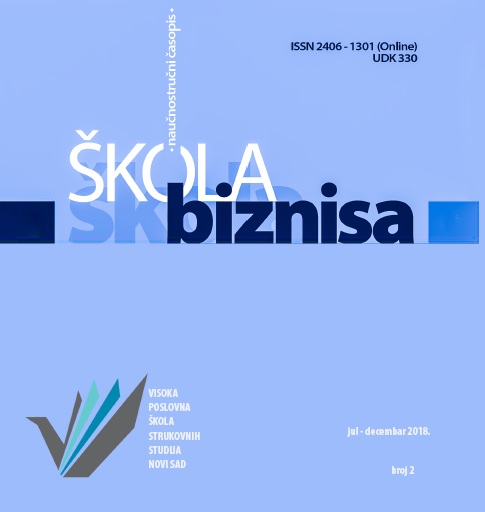HOW FTA AND NAFTA TREATIES AFFECT THE BUSINESS CYCLES SYNCHRONIZATION BETWEEN THE U.S. AND CANADA
Sažetak
Reference
Aguiar-Conraria, L., & Soares, M. J. (2011). Business cycle synchronization and the Euro: A wavelet analysis. Journal of Macroeconomics, 33(3), 477–489.
Aslanidis, N. (2010). Business Cycle Synchronization between the CEEC and the Euro-Area: Evidence from Threshold Seemingly Unrelated Regressions. Manchester School, 78(6), 538–55.
Barunik, J., & Vacha, L. (2013). Contagion among Central and Eastern European Stock Markets during the Financial Crisis. Finance a úvěr-Czech Journal of Economics and Finance, 63(5), 443-453.
Baxter, M., & Kouparitsas, M. (2005). Determinants of business cycle co-movement: a robust analysis. Journal of Monetary Economics, 52(1), 113–157.
Bayoumi, T., & Bui, T. (2010). Deconstructing the international business cycle: why does a U.S. sneeze give the rest of the world a cold? IMF Working Paper, No. 10/239.
Berdiev, A. N., & Chang, C. P. (2015). Business cycle synchronization in Asia-Pacific: New evidence from wavelet analysis. Journal of Asian Economics, 37, 20–33.
Botha, I. (2010). A comparative analysis of the synchronization of business cycles for developed and developing economies with the world business cycle. South African Journal of Economics, 78(2), 192-207.
Calderón, C., & Fuentes, J. R. (2014). Have business cycles changed over the last two decades? An empirical investigation. Journal of Development Economics, 109, 98–123.
Caraiani, P. (2012). Stylized facts of business cycles in a transition economy in time and frequency. Economic Modelling, 29(6), 2163–2173.
Chionis, D., & Leon, C. (2009). Synchronization of the Polish and European Business Cycles. Journal of Economic Asymmetries, 6(1), 119-130.
Chiquiar, D. & Ramos-Francia, M. (2005). Trade and business-cycle synchronization: evidence from Mexican and U.S. manufacturing industries. North American Journal of Economics and Finance, 16(2), 187–216.
Courchene, J. T. (2003). FTA at 15, NAFTA at 10: a Canadian perspective on North American integration. North American Journal of Economics and Finance, 14(2), 263–285.
Croux, C., Forni, M., & Reichlin, L. (2001). A measure of comovement for economic variables: theory and empirics. Review of Economics and Statistics, 83(2), 232–241.
Degiannakis, S., Duffy, D., & Filis, G. (2014). Business cycle synchronization in EU: A time-varying approach. Scottish Journal of Political Economy, 61(4), 348-370.
Ductor, L., & Leiva-Leon, D. (2016). Dynamics of global business cycle interdependence. Journal of International Economics, 102, 110–127.
Duval, R., Li, N., Saraf, R., & Seneviratne, D. (2016). Value-added trade and business cycle synchronization. Journal of International Economics, 99(11), 251–262.
Enea, S. F., Pala, S., & Tiganas, C. (2015). G7 countries – advocates of the global business cycle. Procedia Economics and Finance, 20, 193 – 200.
Imbs J, (2004). Trade, specialization and synchronization. Review of Economics and Statistics, 86(3), 723–734.
Inklaar, R., Jong-A-Pin, R., & de Haan, J. (2008). Trade and business cycle synchronization in OECD countries—a re-examination. European Economic Review, 52(4), 646–666.
Kandil, M. (2009) Spillover Effects of U.S. Business Cycles on Latin America and the Caribbean. Journal of Economic Issues, 18(4), 971-996.
Konstantakopouloua, I., & Tsionas, E. G. (2014). Half a century of empirical evidence of business cycles in OECD countries. Journal of Policy Modeling, 36(2), 389–409.
Kose, M. A., Otrok, C., & Prasad, E. (2012). Global business cycles: Convergence or decoupling? International economic review, 53(2), 511-538.
Fidrmuc, J., & Korhonen, I. (2010). The impact of the global financial crisis on business cycles in Asian emerging economies. Journal of Asian Economics, 21(3), 293–303.
Frankel, J. A., & Rose, A. K. (1998). The endogeneity of the optimum currency area criteria. Economic Journal, 108(449), 1009–1025.
Hanisch, M., & Kempa, B. (2017). The international transmission channels of US supply and demand shocks: Evidence from a non-stationary dynamic factor model for the G7 countries. North American Journal of Economics and Finance, 42, 70–88.
Herrerias, M. J., & Ordonez, J. (2014). If the United States sneezes, does the world need “pain-killers”? International Review of Economics and Finance, 31, 159–170.
Hodrick, R., & Prescott, E. (1997). Postwar U.S. business cycles: an empirical investigation. Journal of Money, Credit and Banking, 29(1), 1–16.
Miles, W., & Vijverberg, C. P. C. (2011). Mexico’s Business Cycles and Synchronization with the USA in the Post-NAFTA Years. Review of Development Economics, 15(4), 638–650.
Montinari, L., & Stracca, L. (2016). Trade, finance or policies: What drives the cross-border spill-over of business cycles? Journal of Macroeconomics, 49, 131–148.
Rana, P. B., Cheng, T., & Chia, W. M. (2012). Trade intensity and business cycle synchronization: East Asia versus Europe. Journal of Asian Economics, 23, 701–706.
Rua, A., & Nunes, L. C. (2009). International co-movement of stock market returns: a wavelet analysis. Journal of Empirical Finance, 16(4), 632–639.
Rua, A. (2010). Measuring comovement in the time–frequency space. Journal of Macroeconomics, 32(2), 685–691.
Torrence, C., & Compo, G. P. (1998). A practical guide to wavelet analysis. Bulletin of the American Meteorological Society, 79(1), 61–78.
Torrence, C., & Webster, P. J. (1999). Interdecadal changes in the ENSO-monsoon system. Journal of Climate, 12(8), 2679–2690.
Torres, A., & Vela, O. (2003). Trade integration and synchronization between the business cycles of Mexico and the United States. North American Journal of Economics and Finance, 14(3), 319–342.
Trancoso, T. (2014). Emerging markets in the global economic network: Real(ly) decoupling? Physica A: Statistical Mechanics and its Applications, 395, 499–510.
Vacha, L., & Barunik, J. (2012). Co-movement of energy commodities revisited: Evidence from wavelet coherence analysis. Energy Economics, 34(1), 241–247.
- Autori zadržavaju autorska prava i pružaju časopisu pravo prvog objavljivanja rada i licenciraju ga "Creative Commons Attribution licencom" koja omogućava drugima da dele rad, uz uslov navođenja autorstva i izvornog objavljivanja u ovom časopisu.
- Autori mogu izraditi zasebne, ugovorne aranžmane za neekskluzivnu distribuciju članka objavljenog u časopisu (npr. postavljanje u institucionalni repozitorijum ili objavljivanje u knjizi), uz navođenje da je članak izvorno objavljen u ovom časopisu.
- Autorima je dozvoljeno i podstiču se da postave objavljeni članak onlajn (npr. u institucionalni repozitorijum ili na svoju internet stranicu) pre ili tokom postupka prijave rukopisa, s obzirom da takav postupak može voditi produktivnoj razmeni ideja i ranijoj i većoj citiranosti objavljenog članka (Vidi Efekti otvorenog pristupa).

